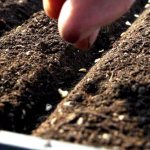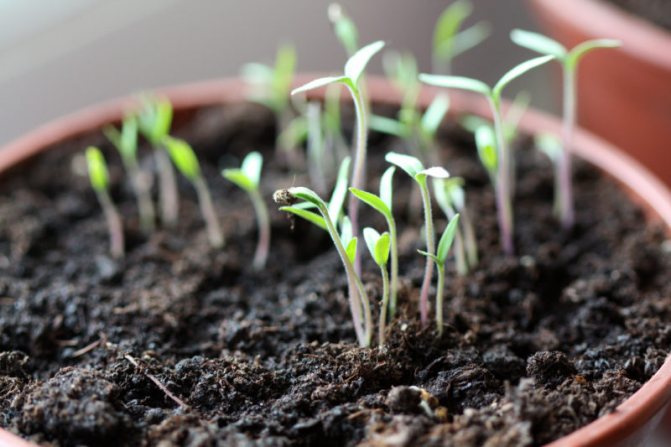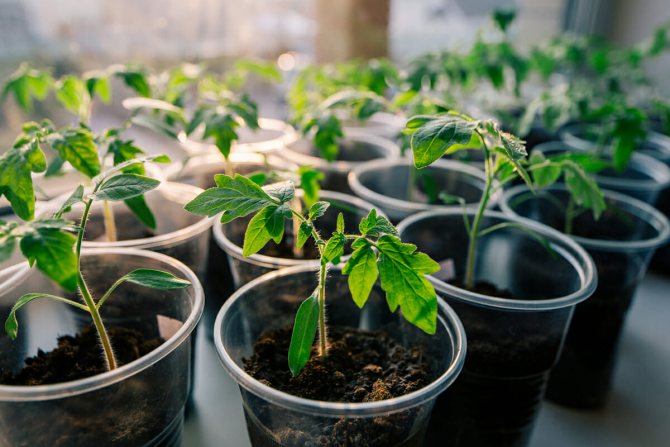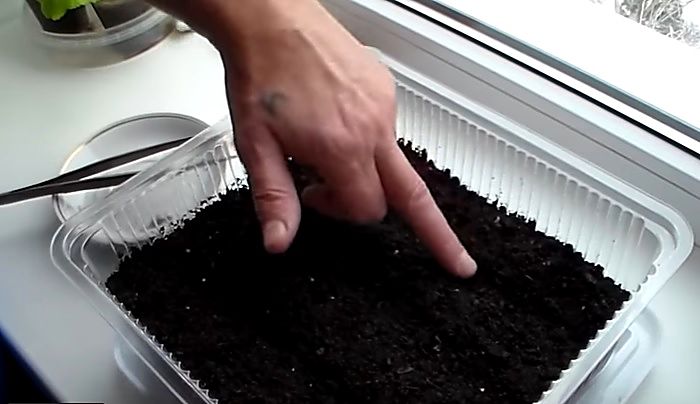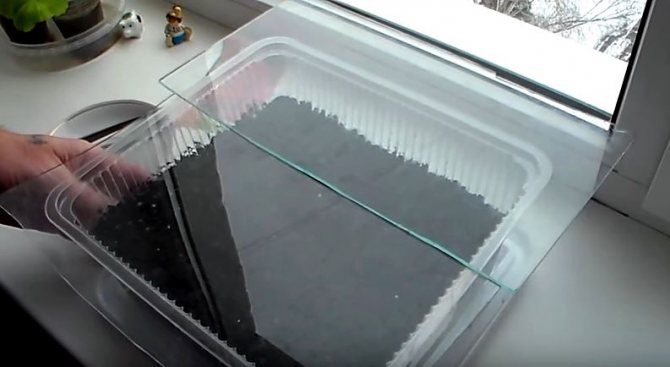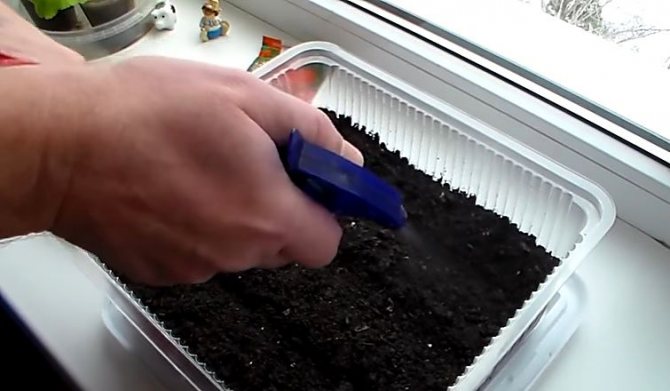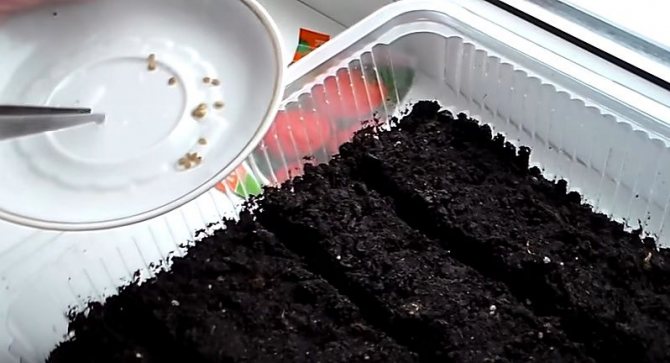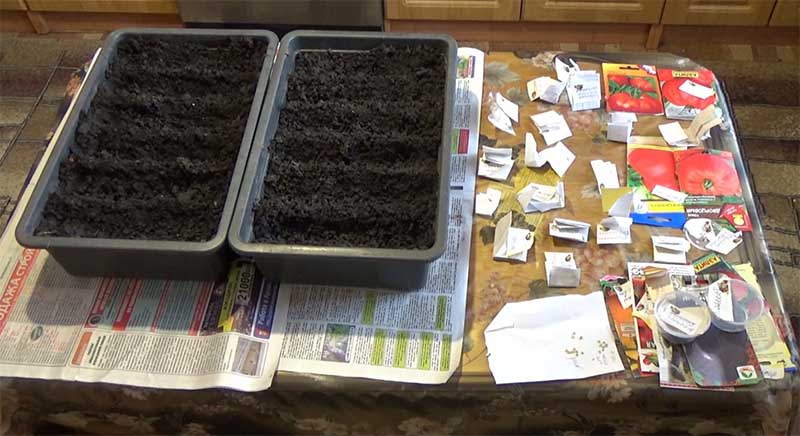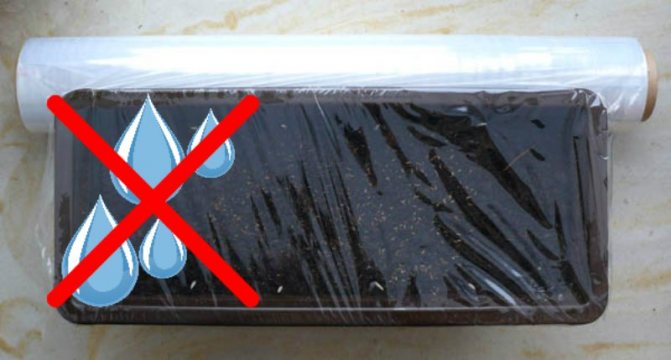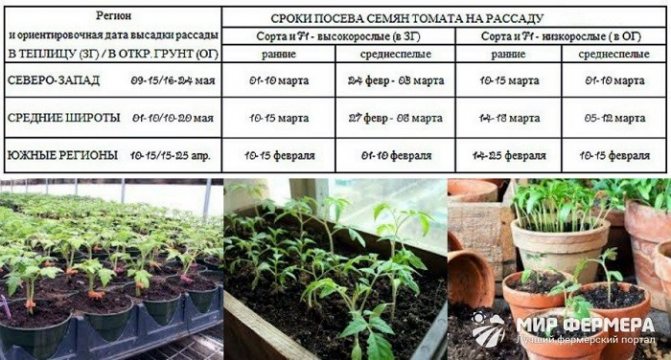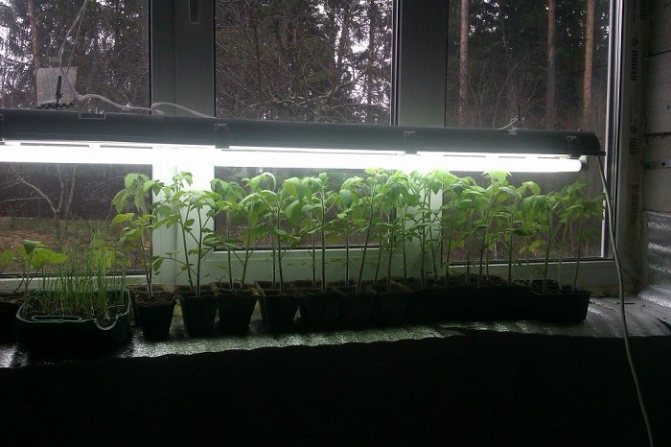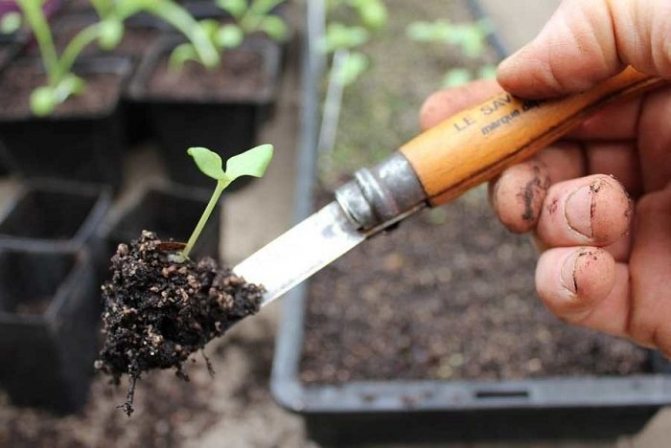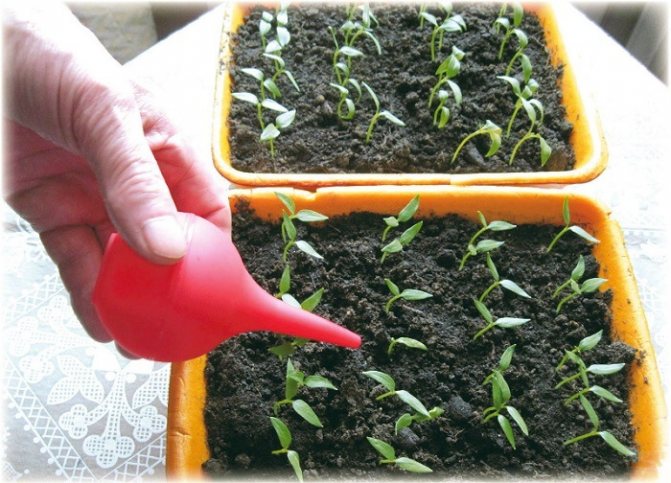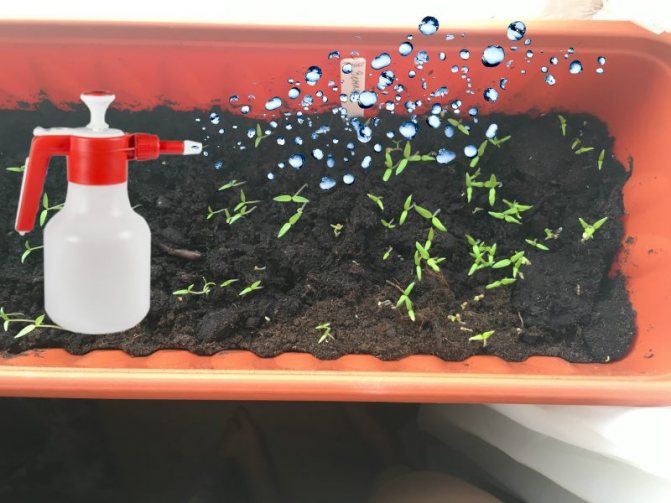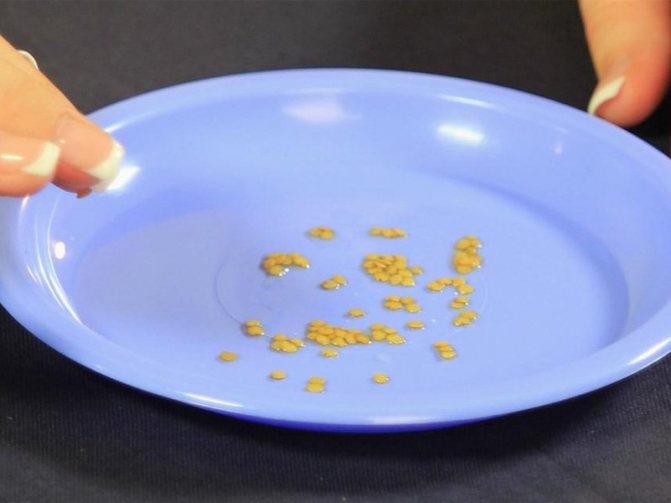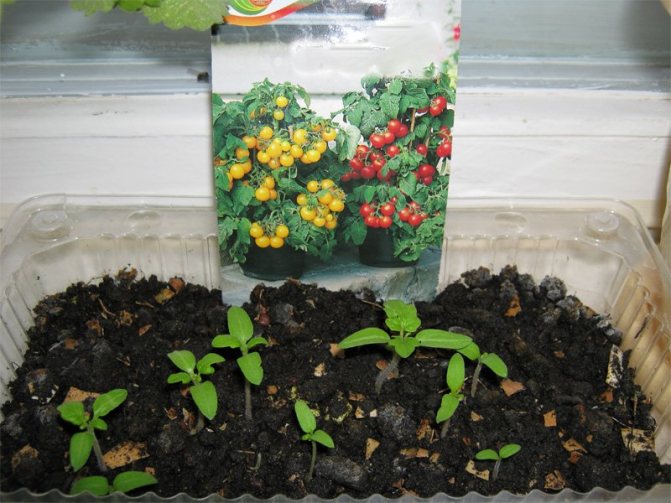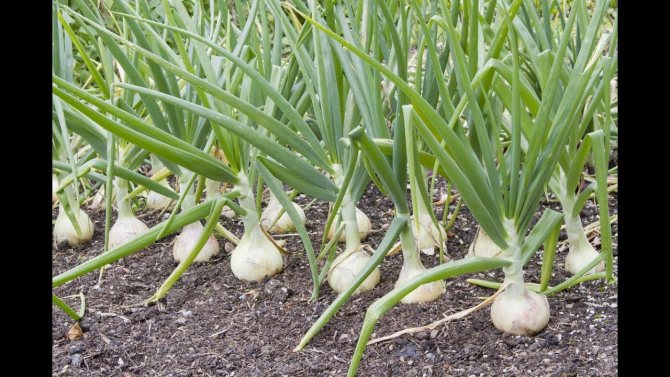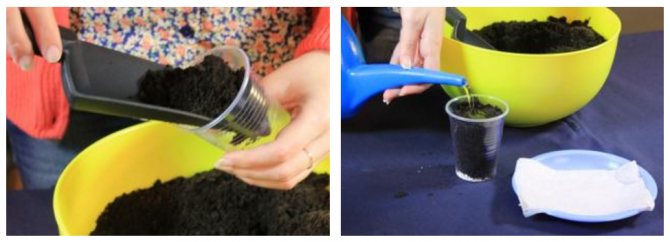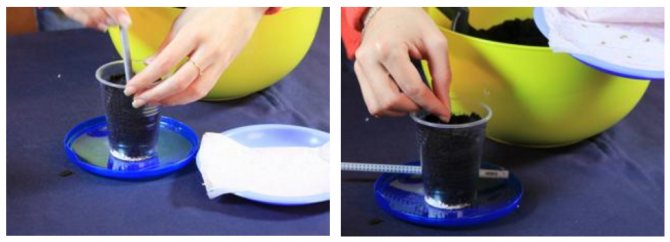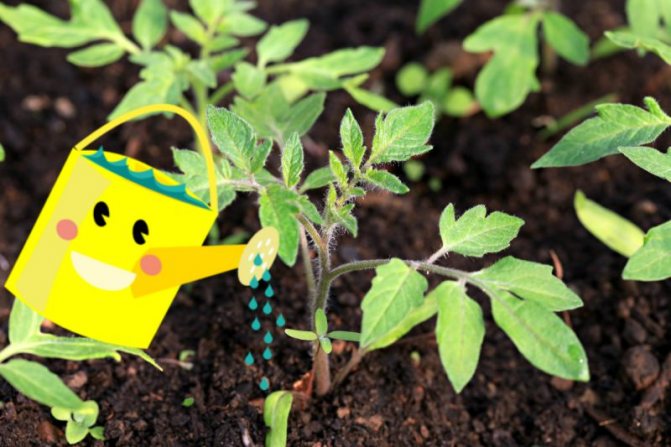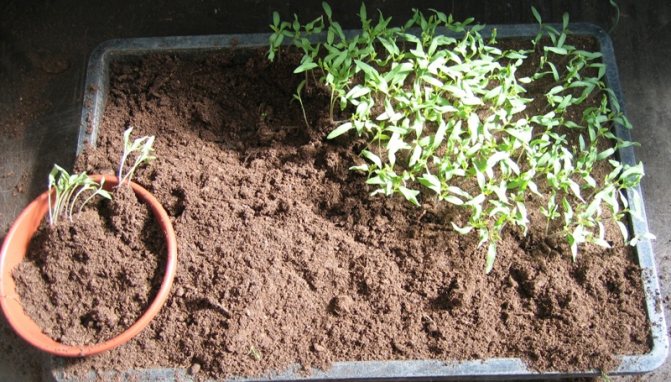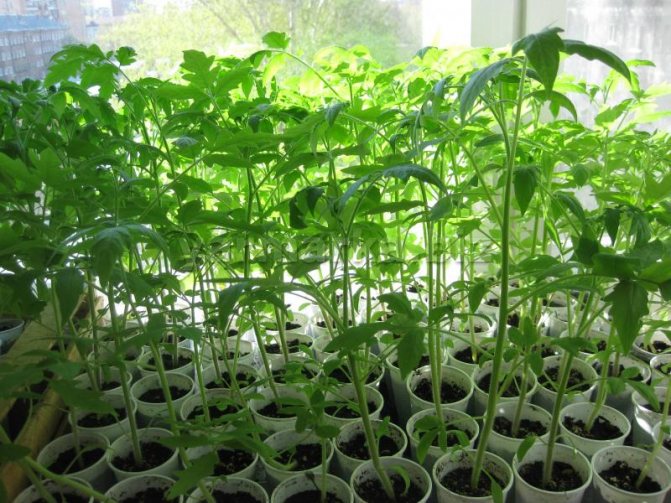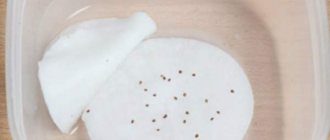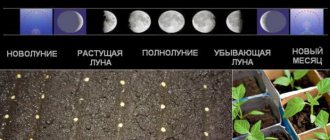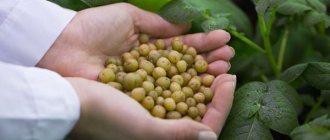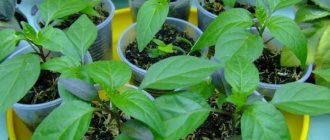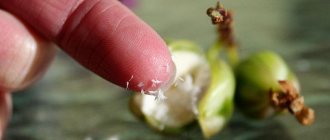The quality of the seedlings affects the future life of the tomato bush - whether it will be able to resist pests and diseases, endure other unfavorable factors, and whether it will give a full harvest as a result. Planting tomatoes for seedlings is a responsible operation, which does not allow for negligence or ignorance of key rules. It is better to buy it on the market if the gardener does not have the right conditions, time or desire to tinker first with the seeds, and then with delicate plants that easily die from improper care.
Let's start by choosing a tomato variety
There are hundreds of varieties of tomatoes, so picking a few can be a daunting task. Here are some criteria to consider:
- Decide on the type of fruitthat you want to receive. For example, it can be medium-sized tomatoes, cherry babies or giant beef tomatoes. There are varieties that are more suitable for fresh consumption, for winter preparations, for making juice or sauce - all this also needs to be taken into account.
- The size of adult plants. Indeterminate tomatoes are tall, their stem can grow up to 2.5-3 m.Determinant ones are more compact, their height is 0.3-1 m.If you want to grow tomatoes in containers - on a balcony or terrace - it is best to choose determinant standard varieties forming a powerful low bush. On bags with seeds of such varieties, there is usually a postscript - "balcony", "room", "patio".
- Disease resistance. Tomatoes are prone to a number of diseases and some of them can reach epidemic proportions. So remember what tomato disease is rampant in your area - late blight, fusarium or something else - and choose a variety that is resistant to this ailment.
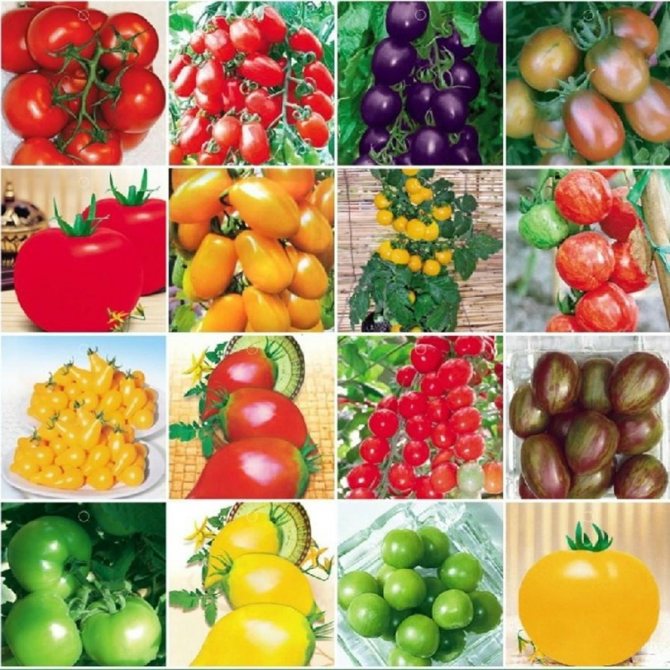
Today there are more than 700 varieties of tomatoes. There are plenty to choose from!
It is also necessary that the growing season of the selected variety is suitable for your region. Remember that if a variety is not zoned for your region, then there will be no good harvest. Rather, it is possible, but only with the artificial creation of conditions unusual for the climatic zone. For an ordinary gardener, these "dances with tambourines" are useless. It is much better to choose a variety that is expected to thrive and bear fruit in your area.
Taking into account the peculiarities of the development of different types of tomatoes and the climate in the region, we can give approximate recommendations for the choice of varieties:
| Region | Suitable varieties |
| 1. North-West of Russia, Baltic (short cool summer, short days in spring and summer) | Determinant varieties of early and medium ripening through seedlings. Early varieties for greenhouses |
| 2. Central and Central Russia, Belarus (warm for about 3 months, enough moisture | Any varieties of early and medium ripening, grown through seedlings. Medium late varieties for greenhouses |
| 3. South of Russia, Black Sea coast, Ukraine (early spring, long summer, drought is possible) | Medium and late varieties grown through seedlings. Early varieties - by direct sowing in the ground. |
Sowing
Drainage is poured at the bottom of the seed boxes, then a layer of about 5 cm of the prepared soil mixture is added, slightly compacted, watered and allowed time for uniform soil saturation.
Seeds are planted in an ordinary way in shallow grooves (0.5-1 cm).A distance of 3-4 cm is maintained between the rows. The seeds laid out in the furrows should be lightly sprinkled with earth and watered well. Cover the container with transparent film or glass and put in heat (about 24 ° C) until the seeds germinate.


When to plant tomatoes for seedlings?
It is very important to set the sowing time correctly in order to have time to get the harvest on time and, at the same time, do not suffer from overgrown seedlings.
The age of a full-fledged tomato seedling, ready for transplanting into open ground, is 45-55 days, depending on the variety. Seeds sprout quickly after sowing - in 5-10 days. Accordingly, tomato seeds should be sown 55-65 days before the intended transplantation into the ground. For example, if you plan to plant seedlings in the OG in early May, then you can sow seeds for seedlings in early to mid-March.
The average terms of sowing tomato seeds for different regions are shown in the table:
| Region | Timing of sowing tomato seeds |
| Ukraine and southern Russia | Sowing from 15 to 20 February. In the ground from April 15 to May 20. |
| Center of Russia | Sowing from March 15 to April 1. In the ground - from May 10 to early June. |
| Siberia, Ural, North of Russia | Sowing from April 1 to April 15. In the open ground — from May 25 to June 15. |
Note for gardeners:
If the tomatoes are to be grown in a greenhouse, then the seeds can be sown 2-3 weeks earlier.
What problems may arise and how to deal with them
Getting a bountiful harvest of tomatoes is not only the correct sowing and seed treatment. Initial soaking in special products does not give a 100% guarantee that the immune system will be fully strengthened.
Diseases such as white and gray rot, black leg occur due to subsequent care errors. Problems can be noticed at the initial stage of the development of infections.
It is worth not only carefully examining the plant, but also timely processing against the invasion of parasitic insects, fungal diseases.
If you notice that the seedling / seedling or an adult tomato bush is withering, and the foliage is pale and thin - it's time to sound the alarm. Being late in therapy is tantamount to killing a tomato.
You can understand what to treat by the following signs:
- Blackleg. The stem dries up in the root zone. Reasons for the appearance: high humidity, too close planting of seedlings. If the soil has not been disinfected, then there is a risk of infection in the soil. To strengthen the trunk, you will have to transplant a tomato bush, treat it with fungicides. Infected tomatoes are disposed of.
- The lack of sulfur is manifested by a change in the sheet plate from the bottom side. Green foliage turns pale pink, wilting occurs. Treatment is with magnesium sulfate. The dilution is slightly different from the instructions (30 g of the product is added to 10 liters of settled water at room temperature).
- Calcium deficiency leads to necrosis (true leaves fall off in the lower part, but the top remains green). The therapy can be carried out by watering with diluted calcium nitrate.
- A lack of potassium makes the edges of the foliage dry (burnt). If untreated, the spots expand, capture the entire plant. Control measures - application of wood / plant ash. In the presence of necrotic (discoloration of the plates) spots, a solution of 0.25% sulfuric iron is required.
- The farmer watches as the leaves roll up and the stalks bend. The color of the green part is white-gray with green veins. Reason: copper deficiency. Copper sulfate, which is diluted to 3%, will help in the fight. Provided that purple leaves are visible and their gradual dying off, then it's time to process the soil with double superphosphate. You can also use ammonium sulfate to remove phosphorus deficiencies.
- With a lack of 4 trace elements (nitrogen, zinc, magnesium and potassium), tomato leaves turn blue, and the development of the culture slows down / stops. Superphosphate is needed to fix the problem.
- Powdery mildew is a frequent visitor in greenhouses and in the open field.The contaminated soil turns white by itself (it seems that it is covered with flour), and white dots and bloom appear on the tomatoes. The leaves wither quickly, the plant dies. Pre-treatment of seeds and soil with a strong solution of potassium permanganate (manganese) or Epin will help to eliminate the problem. There is no instruction, but the strength can be determined by the intense purple color of the solution. Provided that the seedlings have bloomed, and the fungus is spreading intensively, the fungicide, which is intended for this, will help. Processing is carried out after removing diseased leaves, contaminated soil (up to 5 cm of the upper layer).
- White spot also appears due to fungal contamination of the soil. Starts from the bottom. It will help in getting rid of - copper sulfate with the addition of liquid or laundry soap. The soil is abundantly covered with wood ash.
- Late blight infection is manifested by the appearance of dark spots, drying out of the infected parts. Reason: humidity, thickening of plantings, temperature drops. Used for Zaslon therapy.
Soil for growing tomato seedlings
In order to grow healthy tomato seedlings, you need to know not only how to plant it, but also how to properly prepare the soil. It is very important! Poor soil can undermine all your efforts, preventing the sprouts from developing normally.
Soil for tomatoes should be loose, nutritious, moisture-absorbing, not sour (PH-6-6.5).
You can purchase ready-made potting soil at the store. It will have everything you need to grow healthy seedlings.


Soil for tomato seedlings can be bought ready-made
But you can also prepare a mixture suitable for tomatoes on your own.
Here are some soil recipes suitable for growing tomato seedlings:
- sod land, humus, sand in a ratio of 1: 1: 3;
- sod land, peat, humus in equal parts;
- garden land (after legumes, melons) + a small amount of peat and coarse sand.
The mixture must be disinfected before planting in one of the following ways:
- steaming - the soil is poured with boiling water and left to cool;
- calcination - the soil is kept in the oven at a temperature of 100 degrees for 40-50 minutes;
- disinfection with potassium permanganate - spill the soil with a dark pink solution of potassium permanganate;
- freezing - the soil prepared in the fall in bags is left outside for freezing for the whole winter.
After disinfection, the soil is moistened and left at above-zero temperature for 10-14 days. During this time, beneficial bacteria will multiply in the sterile soil, which will make it "live", suitable for growing healthy full-fledged seedlings.
To improve the structure of the soil, it is advisable to add perlite, vermiculite, coconut fiber (about 20%) to its composition. On a bucket of the finished mixture - 0.5 liters of ash, 20 g of superphosphate. All these additives will make the soil for tomatoes more nutritious, friable and moisture-absorbing.
Preparation of containers and soil
An important role in growing tomato seedlings is played by the preparation of the soil mixture and the processing of seedling containers (boxes, individual cups). The plant receives nutrition through the soil, so it must be enriched with useful trace elements and contain all the necessary components for growth. You can prepare it yourself, or buy ready-made soil at a gardening store. The prepared soil is considered versatile and suitable for sowing many other crops.
If the gardener likes to do everything himself, then he will need: sod land, humus and washed river sand, taken in equal quantities. Sand can be replaced with peat. Two matchboxes of superphosphate and 0.5 liters of ash are added to the bucket of the mixture. The result should be a soft and loose soil. It is advisable to prepare soil for sowing tomato seeds in the fall and store it in the cold. Frost will kill all disease causing bacteria.
If it was not possible to freeze the soil, it should be disinfected.You can spill it with boiling water or a solution of potassium permanganate, ignite or use the biological fungicide "Fitosporin-M", according to the attached instructions.
It is advisable to disinfect the soil two weeks before sowing: during this time, the microflora necessary for the full development of seedlings will have time to recover.
As soon as everything is ready, you can fill the containers intended for this, be it general boxes or individual containers. When planting in a common container, the seedlings will need to be dived in the future. The height of the container should be deep enough (8-10 cm), so that in the future there would be a place for the development of the root system of the plant.
Presowing seed preparation
Seeds from renowned manufacturers, packaged in bags, do not require any preparation. If the seeds are bought by weight or collected with their own hands, they must be prepared for sowing.
What should be done?
- Reject seeds by hand - view and remove small, wrinkled, empty, dark seeds.
- Soak the seeds in a 3% sodium chloride solution. For this, the seeds are placed in a saline solution, mixed and waited for 5-7 minutes. Seeds that float up - empty, can be thrown away, settled to the bottom - viable, they need to be washed and dried.
- To protect seedlings from diseases, seeds are disinfected before sowing, as they can be infected with viral and fungal diseases.
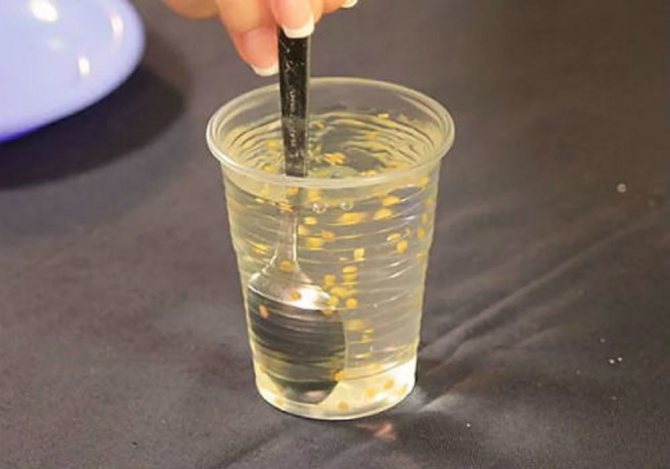

Calibration of tomato seeds in saline
The most popular disinfection methods are:
- Soaking the seeds in a 1% solution of potassium permanganate for 20 minutes, followed by rinsing with clean water;
- Soaking for 1-2 hours in Fitosporin M, Baikal - 1 drop of the drug in 100 ml of water;
- Soaking in a soda solution - 1 g of soda per 200 ml of water, the seeds are dipped in a solution for 24 hours - this stimulates early fruiting.
- Soaking in an aqueous solution of aloe juice (1: 1) for 24 hours - this increases immunity, improves yield, fruit quality.


Disinfection of tomato seeds in a solution of potassium permanganate
To nourish seeds with useful substances, many experienced gardeners soak them in growth stimulants (Zircon, Epin).
To increase the stress resistance of future seedlings (it tolerates picking more easily, easily takes root and tolerates acclimatization), seeds are also hardened. This is done as follows: the swollen seeds are wrapped in a damp cloth, placed in a plastic bag and left in the refrigerator for 2 days.
Pre-germination is also often practiced, which shortens the time for germination by several days. For this, the seeds are washed and placed in a damp cloth in a warm place for 2-3 days. As soon as the seeds hatch, they are planted in the ground. This must be done with the utmost care, because delicate sprouts and roots break off easily.
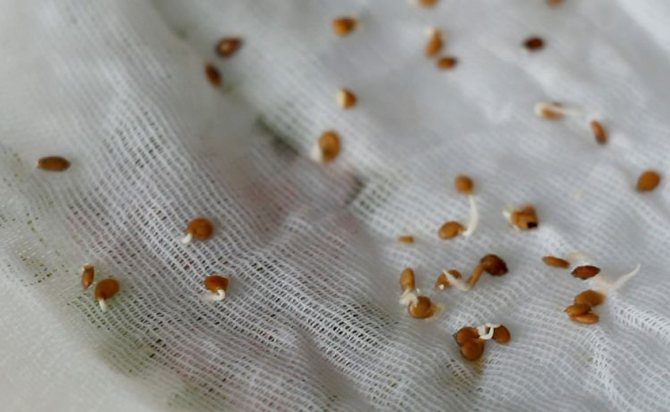

Pre-germination of tomato seeds in a gauze bandage
Note!
It is not necessary to carry out all these actions, even dry high-quality seeds will necessarily germinate. And, with good care, the seedlings will be healthy and strong!
When to sow tomatoes according to the lunar calendar 2020
Let's take a look at the gardener's lunar sowing calendar and highlight the dates that promise an excellent tomato harvest. Let's note the days on which it is better not to carry out work related to the sowing and planting of vegetables.
| Month | Auspicious days | Forbidden days |
| January | 4-7; 9-10; 27-29; | 11; 24-26; |
| February | 1; 2; 6-7; 24; 25; 26-28; | 3; 8-9; 17; 21-23; |
| March | 1-2; 4-6; 26; 28;31; | 9; 19-21; 24; 27; |
| April | 1-2; 24-25; 27-29; | 8; 16-17; 21;23; |
| May | 6; 25-28; | 7; 13-14; 22-23; |
| June | 6; 9; 10; 21; |
Where can you grow high-quality tomato seedlings?
Any container that holds the soil and has drainage holes is suitable for growing seedlings. These can be wooden or plastic boxes, cassettes, pots, individual plastic cups, yogurt and butter containers, egg trays, etc.
Peat tablets and peat cups are also used for seedlings.


Containers for growing tomato seedlings - pots, boxes, cassettes
How to plant tomato seeds for seedlings
Before sowing, prepare the selected container - clean it from the remnants of old soil, wash it with soap and soak in a dark pink solution of potassium permanganate for 15-20 minutes.
At the bottom of the container, lay a drainage layer of expanded clay, crushed foam, eggshells, broken bricks, etc.
Further actions will depend on the type of landing tank selected
1.Planting tomato seeds for seedlings in common boxes
Fill the container with a damp soil mixture so that it does not reach the sides of 2 cm. Make grooves every 4-5 cm, 1 cm deep. Place the prepared tomato seeds with tweezers every 1-2 cm. Sprinkle with soil on top and cover with glass or a plastic bag, creating microclimate with humidity 80% -90%. Next - put the box in a warm place for germination.
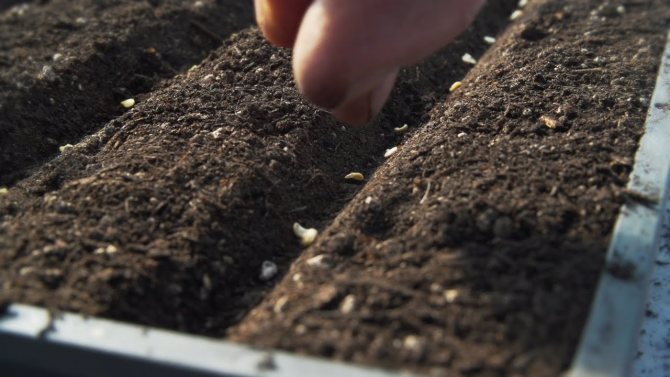

Shared boxes allow you to save space on the windowsill when growing a large number of seedlings. But, at the same time, such a choice of capacity requires the mandatory subsequent picking of seedlings
2. Planting tomato seeds for seedlings in separate containers
For planting, use separate cups or pots with a diameter of 10 cm, a height of 10-12 cm.
Fill the containers with soil, tamp a little and place 2 tomato seeds in the middle, in a 1 cm depression. Cover with foil (glass) and place in a warm place for germination. Leave one, stronger plant after germination.


Cardboard cups are good for growing seedlings, which can be broken when transplanting
3. Sowing tomatoes in peat tablets
Growing tomato seedlings in peat tablets allows you to do without picking.
For seeding, spread the tablets in any suitable tray, cover with water. After the tablets have swollen, put a seed in the middle of each, sprinkle with soil. Cover the tray with plastic wrap and place on germination.
When 2 leaves appear, the roots will fully germinate through the pill mesh. Then the tablet is simply planted in a plastic cup, adding fresh soil to it.


Peat tablets are an excellent medium for growing tomato seedlings
4. Sowing in plastic containers (cassettes)
Recently, plastic containers with cells (cassettes) are often used for planting seeds for seedlings. They are easy to transport, they can be used repeatedly, they are easy to clean and the seedlings planted in them do not require picking.
To plant the cells of the cassettes, fill with soil or put peat tablets in them. Sow tomato seeds and water gently, cover with a transparent lid or plastic wrap.


Plastic cassettes are another option for choosing a seating container, which allows you to do without a traumatic pick
On a note:
In all cases, containers with planted seeds are placed for germination in a warm place with a temperature of 25-30 ° C.
How to sow tomato seeds for seedlings, using various planting containers, is described in the video:
The first stage of growing tomato seedlings is very important. Therefore, even before emergence, soil moisture must be carefully checked and condensation removed. If necessary, irrigate the soil with water from a spray bottle or open the plantings to dry.
Sometimes, when humidity is high, mold forms on the soil surface. In this case, carefully remove the upper infected layer and spill the soil with a solution of potassium permanganate or an antifungal drug (Fitosporin, Fundazol).
The first tomato sprouts appear in 3-4 days. Germination time directly depends on temperature:
- 28-32 ° C - 4-5 days;
- 24-26 ° C - 6-8 days;
- 20-23 ° C - 7-10 days;
- less than 20 ° C - 10-14 days or more.
Seedlings that appeared later than 5 days after the main group are best removed.
Content
- When to plant tomatoes for seedlings in 2020 January
- February
- March
- April
- May
- Priming
- Growing conditions
Caring for tomato seedlings at home
Lighting
When the first shoots appear, take out the seedlings to the brightest place. However, direct sunlight should be avoided so that the sprouts do not boil or get sunburned.
When sowing early (January-February), light up the sprouts. The first 2-3 days - around the clock, then - 16 hours a day. To do this, you can use LEDs, fluorescent lamps or conventional incandescent lamps.
The backlight is first placed at a distance of 20-25 cm, when the seedlings grow up, the lamps are raised.


LED lighting over tomato seedlings
Temperature regime
For seed germination, a temperature of about 22-28 ° C is required.
Immediately after germination, the temperature should be reduced to 13-15 ° C during the day and to 10-12 ° C at night. At this time, the roots develop well and the leaves do not grow.
7-10 days after germination, the seedlings begin to grow leaves and the temperature is raised again to 22-24 ° C during the day, 18-20 ° C at night. This alternation of temperatures will allow both the leaves and the root system to develop. The worse the illumination, the lower the temperature should be, and vice versa.
Watering
In the early days, the seedlings are in the greenhouse. Do not remove the film immediately after germination, but gradually open it so that the tomatoes get used to the fresh air. After 1-2 weeks, the film can be removed.
Under the film, tomato seedlings practically do not require watering, but you still need to monitor the condition of the soil and prevent the top layer from drying out. The roots of young shoots are superficial, tender, and can easily die at the slightest dryness.
But it is also dangerous to flood tomato seedlings, the plants can get sick. black leg. This is a fungal disease that can kill all seedlings. Watering should be done carefully under the stem with a syringe or spoon. Watering frequency is proportional to light and heat. With an increase in temperature and light, the plant starts to grow and it needs more water, watering more often and vice versa.
For irrigation, use settled water 2-3 ° C higher than the air temperature.
Quenching and fresh air
At the time of germination, young tomatoes have an innate protection against UV rays. And you will be lucky if the sprouts sprout on a sunny day - they can be immediately taken out in the sun without fear of burns. This will increase the stamina of the tomatoes in the future.
If you did not have time to do this on the first day, then you will have to gradually accustom tomato seedlings to fresh air and sun. The first day - 5-10 minutes in the air is enough. Gradually increase your walking time on the following days. After 7-10 days, at a temperature of 15-20 ° C, you can completely transplant the seedlings to the balcony or terrace.
Top dressing
You can feed the seedlings once a week in small doses (half the dose from the norm for an adult plant), alternating mineral fertilizing with organic ones. When the first true leaf appears, apply fertilizer with a high phosphorus content (for example, Master 13-40-13).
Further, depending on the state of the tomatoes, add fertilizers of natural origin to the "diet" (infused bird droppings, fermented grass, humus, ash).
Before planting in the ground, it is necessary to feed the plants well with a high-potassium fertilizer (for example, Master 13-11-38 + 4) to increase the sucking power of the roots after transplanting. All the nuances of caring for tomato seedlings from emergence to picking are described in the video:
Growing conditions
It is believed that with the right approach, from a gram of tomato seeds, you can get 200-250 powerful bushes with a well-developed root system.In practice, not every gardener can boast of such results, and only because few people know what conditions should be created.
For tomato seedlings, air temperature is of great importance, which is changed depending on the stage of plant development:
- when the seeds are soaked and before their germination, the temperature is maintained at about 20-25 ° C in the room;
- the first week after germination, the daytime temperature is 14-16 ° C, and the nighttime temperature is 10-12 ° C;
- starting from the eighth day, the temperature is gradually increased to 22-24 ° C during the day and 12-14 ° C at night.
The temperature is especially important at the second stage, when the root system begins to form in young plants. At the same time, it is important to protect the seedlings from drafts, therefore, a temporary film shelter is arranged over the containers.
The length of daylight hours is important. A tomato needs 15-17 hours of light a day, otherwise it starts to develop incorrectly.
Pickling tomato seedlings
Picking - planting seedlings in separate cups.
If the tomatoes were planted in common boxes, then a pick is necessary. It is carried out in the phase of 2 true leaves.
Note!
Experienced gardeners advise pinching the central root by 1/3. This promotes the growth of a powerful root system, but the roots are injured and the tomatoes slow down growth for a week.
Pick technology:
- Fill the prepared cups with soil, water it and make a hole in the center.
- Transfer the seedling to the hole, place the roots loosely, deepening to the cotyledon leaves.
- Sprinkle soil over the hole.
- After picking, shade the plants from the sun's rays - for 2-3 days. During this period, the direct sun can become destructive and harm the seedlings that have not yet taken root.
Further care consists in watering, feeding, loosening.


Picking tomato seedlings into separate cups
Important!
The first pick of tomatoes is made in 200 ml cups. After 2-3 weeks, when the seedlings outgrow these containers, you can transfer them to 0.5-1 l pots.
And you will learn how to care for tomato seedlings after a pick by watching the video plot:
Moon phases
It has been proven that the movement of plant sap is subject to the lunar effect. The planet's cycle is traditionally divided into 4 phases. In each of them, agricultural work is carried out, taking into account the condition of the plants:
- IN New moon try not to disturb neither seedlings of tomatoes, nor later adult plants. Can be cultivated and weeded. If the seeds are collected at this time, they will not lose their germination even after long-term storage.
- Waxing CrescentThe period lasts about 11 days and favors active plant growth. At the beginning of this phase, it is good to plant low-growing tomatoes, and at the end of the phase, tall ones.
- Full moon. This short period of time is suitable for weed removal and disease prevention and control. It is better not to do other work for now.
- Waning moon.During this period, lasting up to 12 days, the tomato root system must not be damaged. Therefore, you should not do a pick or change. But the ground parts of the plant are quite possible to do: water, feed, cut and, if the time is right, collect the seeds.
For a full lunar month, the planet passes through all the zodiacal constellations. Some of them are recognized as more fertile, and some - less and even sterile. We must also take this into account.
Znlike Libra, Taurus and Scorpio and are more favorable. Tomatoes, the planting of which fell on the constellations of Aries, Leo, Aquarius and Sagittarius, are unlikely to please with good development and excellent fruits.
What days of the first months of 2020 are favorable for sowing tomatoes


On the arriving moon, which is by this time in Pisces or Taurus, the picking of plants will be successful. When the waning moon passes through the signs of Capricorn, Scorpio or Sagittarius, the seedlings should not be disturbed.
Unfavorable days for planting tomatoes in 2020
For this time, actions should be postponed not only for planting seeds, but also for pre-sowing preparation. Soaking, disinfecting and calcining will not give the expected effect in the future if they are carried out:
- January - 10, 24, 25, 26
- February 9, 22, 23, 24;
- March 9, 23, 24, 25;
- April 8, 22, 23, 24.
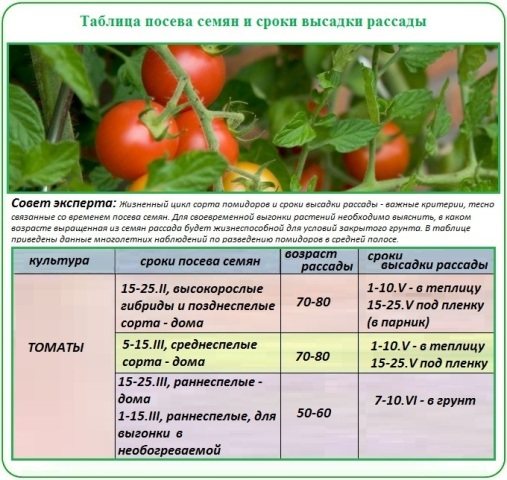

Preparing seedlings for planting in open ground
The grown seedlings must be prepared for transplantation into the exhaust gas. 10-14 days before planting, start hardening young tomatoes, gradually reducing the temperature of the content from 18-20 ° C to 14 ° C. For the last 5-6 days before disembarking, take out the seedlings to the balcony, gradually increasing the time spent there up to a day.


Tomato seedlings must be hardened by taking out every day to fresh air.
At the age of 1.5 months, tomato seedlings expel the flower brush. Therefore, it is necessary to plant seedlings for permanent residence. It is impossible to delay the transplantation, this will lead to a decrease in the yield. If transplantation is not possible, the first brush must be removed.
Before planting, seedlings should be 25-30 cm high, have a thick stem, large leaves, a powerful root system, and developed buds.
2 days before planting, stop watering the seedlings so that the soil sticks better to the root.

